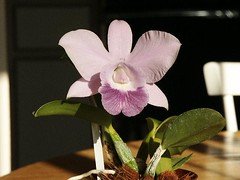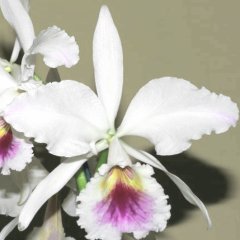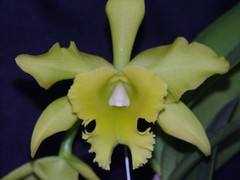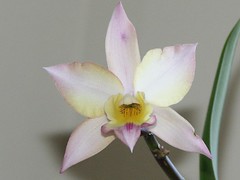The Cattleya orchid is also called the “corsage orchid” because in the old days fashionable ladies used to sport an oversized Cattleya corsage to special events. Even though it is not so common to wear corsages anymore, the Cattleya orchid is still extremely popular among amateur and professional growers. They are perfect as cut flowers because they are long-lasting and come in an array of colors. The blooms are usually quite big; I’ve seen enormous Cattleya flowers that are as big as my face. (And I don’t have a small face by any standard!)
The discovery of Cattleya was an accident. In the nineteenth century, a moss and lichen collector just grabbed some random sturdy leaves in the forest as packing material to protect his collections en route from Brazil to England. A horticulturist, William Cattley, saw the strange packing material and decided to grow it. Few years later, the strange plant produced some stunning blooms that rocked the world. The genus was therefore named Cattleya as a tribute to William Cattley, and the plant was then named Cattleya labiata. From then on, people started the crazy hunt for wild orchids in South America.
To this day, Cattleya orchids still define orchids; they are the benchmark of orchids. You may hear growers say “grow this orchid like Cattleya except a bit less light” or “this orchids need the Cattleya temperature.” Because Cattleya species are founded throughout tropical Central and South America, these orchids like intermediate to warm temperatures (55 to 65°F/13 to 18°C in winter nights and 15°F/10°C or so warmer during the day) and medium bright light. At home, it’s best to grow your Cattleya orchid by the southern, eastern or western windowsills. Provide as much light as it can take without burning the leaves; touch them to make sure they are not hot. When the plant receives its upper limit of light, it will show you a reddish tinge.
Since Cattleya orchids are epiphytes, they like their potting material to dry out between watering. Or if you live in humid area, you can even mount your orchid on a slab of wood or on the tree in your garden. That way, you would never over water your plant!
American Orchid Society provides a good one-page free culture sheet on Cattleya, so you can print one out as a reference.
Cattleya Hybrids
The advantage of growing hybrids is that they can flower more than once a year. (Usually species can only flower once a year.) Breeders developed hybrids by breeding Cattleya orchids with related genera. For example:
Cattleya x Laelia = Laeliocattleya (Lc.)
Cattleya x Epidendrum = Epidcattleya (Epc.)
Cattleya x Brassavola x Laelia = Brassolaeliacattleya (Blc.)
As you can see, the names are not super creative, because some orchid people are way too serious. They are just combing the genera together. But that way it is easy for us to understand what the makings are. When four or more genera are involved, people are forced to come up with more creative names like:
Cattleya x Brassovola x Laelia x Sophronites = Potinara (Pot.)
Cattleya x Brassavola x Laelia x Dialaelia = Iwanagara (Iwan., short for I wanna grow ya!)
It is not very important to know these names, but if you happen to get a plant that has one of these abbreviations, then you know what they mean. The Cattleya hybrids require more or less similar growing conditions as the Cattleya species. But when you get into orchids a little more, you would know that, for example, Brassavola requires very bight light, so its hybrid with Cattleya also needs a bit more light.
Cattleya Species
Don’t limit yourself to grow just Cattleya hybrids. You should also try growing the species as they are equally
rewarding, if you can stretch your idea of equally rewarding to mean that they bloom half as much. My first recommendation is Cattleya intermedia. Mine faithfully blooms for me despite my neglecting it. They come in many different colors, such as pink and white. My Cattleya intermedia is white with a hint of blue, and the lip is partly reddish pink. These beauties are originally from Brazil, Uruguay and Paraguay.
Another one you should try is Cattleya bicolor. I love that these flowers look so waxy that they don’t even look real. They are bifoliate (each bulb has two leaves instead of one) and can bear up to five 2.5 inch (10 centimeter) flowers. The pink, green and reddish-brown bloom can give you weeks of enjoyment.
Happy growing!






